A large group of around 60 members of the Friends visited three churches on the Isle of Sheppey on 14 June 2023, including the recently restored Sheerness Dockyard Church. The weather was fine, the traffic slightly less so; and we had tea at Minster.
Queenborough, Holy Trinity
Holy Trinity is unusual amongst medieval churches in that it was a late foundation: most rural churches in England are Saxon foundations and therefore were in existence at the time of the Norman conquest. But Holy Trinity came much later. Its origin is Edward III’s decision to fortify the Thames estuary against French raids: he built a castle at Queenborough in 1361-77, founded the church in 1366 and made the town a free borough in 1368. The ‘Queen’ in Queenborough was his wife, Philippa of Hainault.
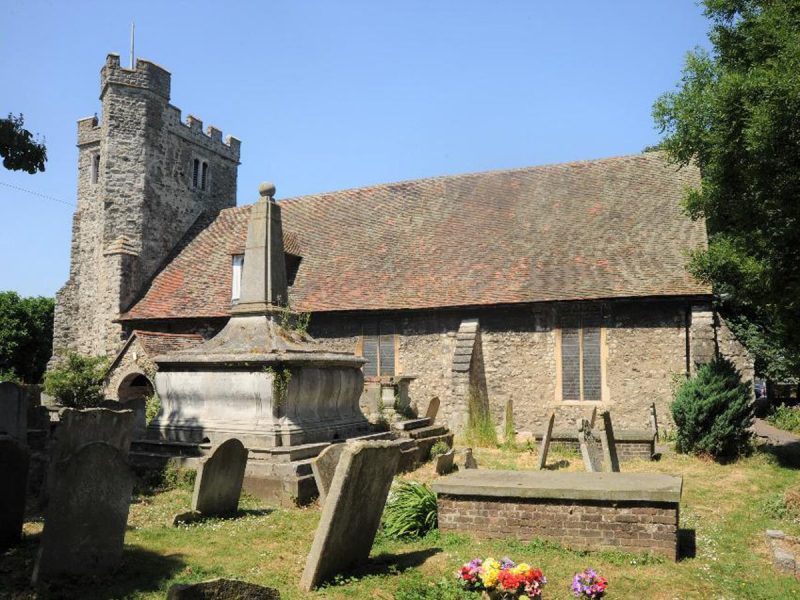
The church is therefore that rare thing, a parish church which was a royal foundation. The building was paid for by the King and the fact that it is so modest may indicate that the Royal finances at that point were not in good shape (Edward was always heavily in debt because of the need to finance his French wars). Apart from the top stage of the tower, for which a bequest was left in 1480, and the tower buttresses, strengthened in 1636, the whole building is of the 1360s/70s and therefore it tells us something about the state of development of early Perpendicular architecture in Kent. All the windows were renewed in the restoration of 1885 but this seems to have been done accurately, except for the east window which looks like the restorer’s invention. The two dormers in the nave to admit extra light are worth noting – they must be post-medieval insertions; and so is the stair turret of the tower which is a part-hexagon rather than the more usual octagon.
The most striking feature of the interior is the boarded roof, charmingly painted in the late 17th century with an angel, cherubs and lots of clouds. It is now very dirty and darkened by varnish but cleaning it would transform it and there are plans to do this.
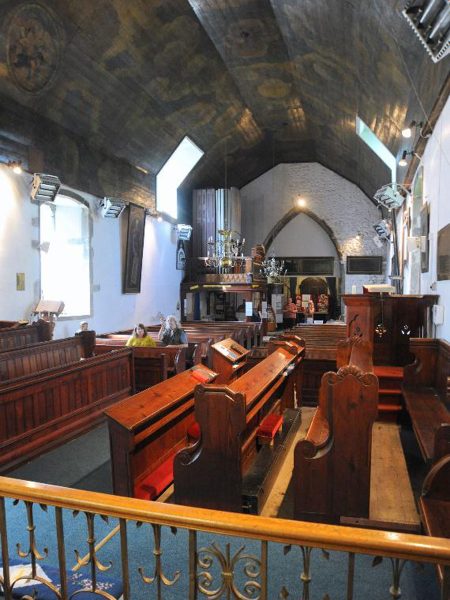

Of the fittings, much the most interesting is the font, dated 1610, which has, on the bowl, a stylised relief of the castle. The latter was at the eastern end of the town – you can still see the earthworks – but was demolished in 1650.

Other fittings worth noting are the font cover, perhaps also 17th century, and from the 18th century the chandeliers, Royal Arms of Queen Anne and the paintings of Moses and Aaron from a former reredos. The glass in the east window is good – it is signed by Cox and Buckley 1883.
Lastly, we looked at the churchyard, crowded with monuments, including the vast mausoleum of about 1830 to the Greet family; and at the little High Street of this shrunken borough (which had two MPs until the 1832 Reform Act) with its charming 18th century buildings.
Dockyard Church, Sheerness
The Dockyard Church was built in 1828 next to the Naval Terrace. Both church and terrace were designed by the surveyor to the Admiralty, George Ledwell Taylor. The church, which has a grand four-column portico to the east surmounted by a bell-tower, is built of yellow brick with sandstone dressings and is very stately. The interior, which had galleries, was extensively remodelled following a fire in 1881.
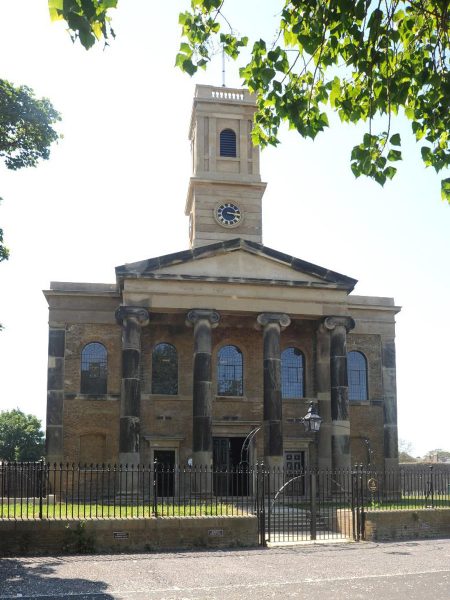
The navy having left in the 1960s, the church was sold to a private buyer and in 1981 was for a second time accidentally gutted by fire – an unlucky building. Almost everything within was destroyed except the cast iron columns supporting the gallery and those at the west end supporting the tower. The building has recently been re-roofed and repaired by the Sheerness Dockyard Trust with the benefit of Lottery funding and to a design by Hugh Broughton Architects. No attempt has been made to recreate the 19th century interior but rather a frankly modern structure sits within the shell of the old building, galleries accommodating workstations with an open exhibition space and café at ground level. The building, opened formally just before our visit but at that stage still inaccessible to the public, is to be operated by ‘IslandWorks’ and will house an enterprise centre, events venue and café.
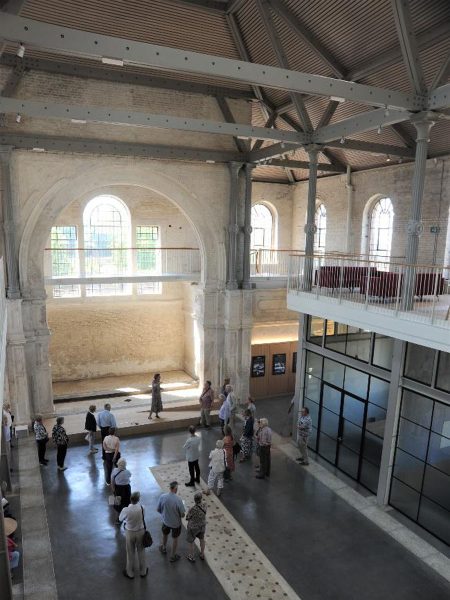
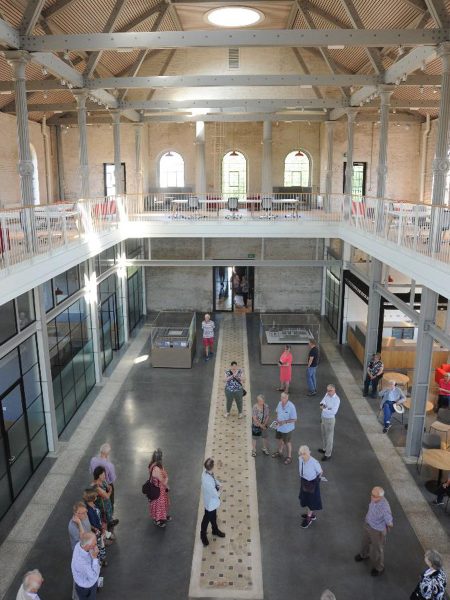
We were very grateful to Amicia Oldfield, a trustee of the Dockyard Trust, for arranging for us to see this most impressive transformation of a building which had been a forlorn ruin for so many years.
Minster in Sheppey, St Mary and St Sexburga
What a venerable place! Sexburga, widow of King Ercombert of Kent, who died in 664, founded a nunnery here, of which she became abbess. The nuns’ church is the northern of the two conjoined buildings one sees here; the southern one, separated from the nuns’ church by an arcade, was the parish church. No doubt before the Reformation the nuns’ church was screened from the parish church to give the nuns privacy and prevent easy access. The nuns’ church had a chancel to the east, most of which was demolished after the dissolution of the priory in 1536, when the entire building became parochial. You can see the scar of this chancel outside.

Much of the nuns’ church is Anglo-Saxon, not of St Sexburga’s time but probably of the 8th or 9th century. Its nave measured about 50 feet by 26 feet. Its north wall is visible outside, with traces of two windows just east of the tower and its north-east corner or quoin embedded in the wall further east. In its south wall, inside and above the arcade between the two churches, two blocked windows with arches made of Roman tiles are visible. There were no aisles – Anglo Saxon churches did not have aisles. The chancel arch of the nuns’ church is 13th century and the one remaining bay of the chancel 14th century.
The parochial church is of the 13th century: there are three lancets in the east wall, two in the south wall amongst other, later, windows, and one left from a trio in the west wall with a circular window above. The fine south doorway is also of the early 13th century. The arcade between the two churches is of the 13th century, too, with octagonal piers (and one round one). The arch between the chancels is 14th century.
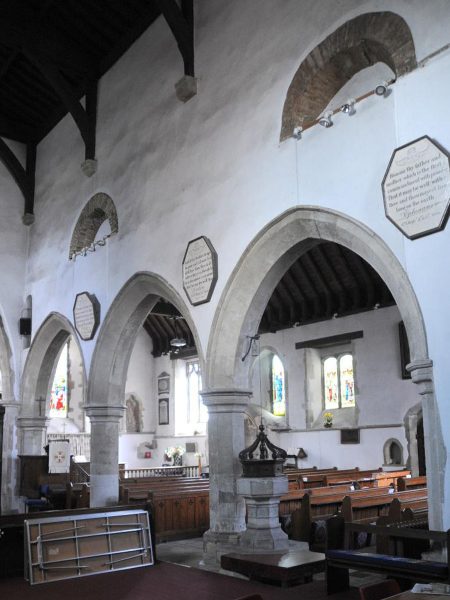
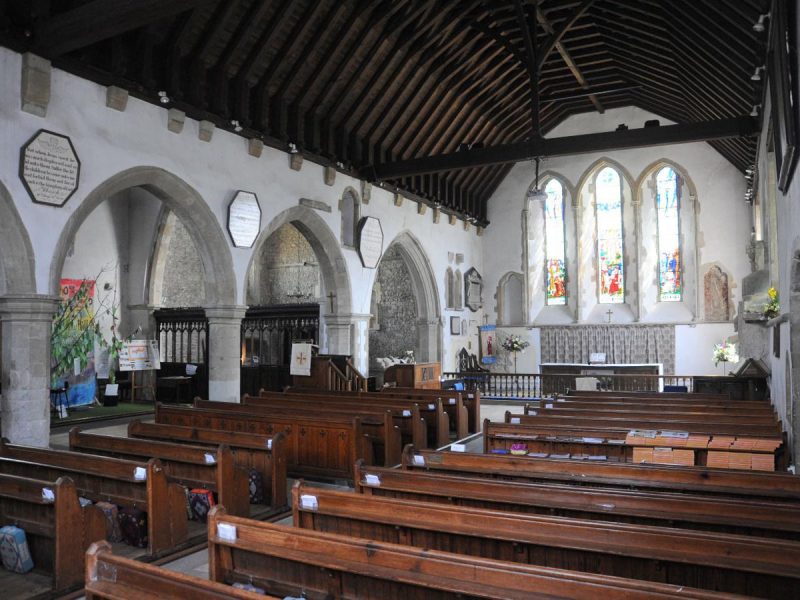
In the early 16th century, the priory began a massive new west tower, of which only the first stage was built before the Reformation intervened. It was evidently for shared use because there are separate staircases from the nuns’ and parish churches. After 1536 it was capped with a timber, tile-covered belfry.
There is not much in the way of fittings. Best is the rood screen in the nuns’ church, which is of much the same date – late 14th century – as that at Harty. There is also a simple Perpendicular font with a nice Jacobean cover.
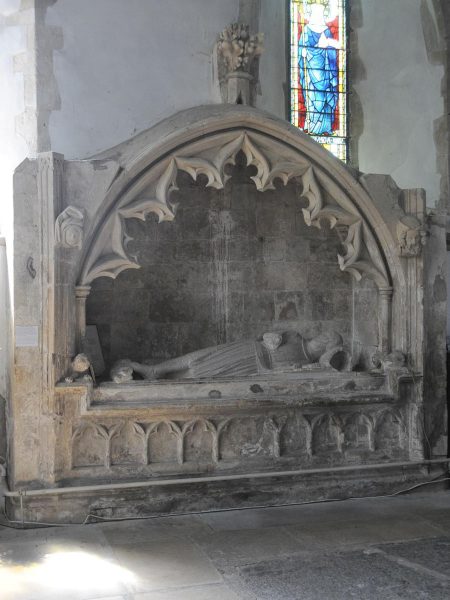
Monument to Sir Robert de Shurland
The monuments are another matter. The earliest is a 13th century coffin lid with relief cross propped up against a wall in the nuns’ chancel. The grandest is that to Sir Robert de Shurland in the parochial nave. His effigy lies, legs crossed, his head resting on his helmet, under a big canopy with exquisite heads, and dates from about 1325. The head of his horse is carved next to his effigy, a most unusual conceit. There are more-or-less contemporary effigies of another cross-legged knight and of a lady, and a mid-15th century knight in the nuns’ chancel, which had been buried in the churchyard and was dug up in 1833. It is somewhat damaged. Also in the nuns’ chancel is William Cheyne who died in 1487, again in armour and under an arch. His effigy is of alabaster. Between the two chancels is the armoured figure of Sir Thomas Cheyne, who died in 1559. Several of these monuments are not in their original positions: the Cheyne monuments were originally in a separate family chapel. Others were no doubt further east in more prestigious positions the nuns’ chancel. It is clear that the priory was a favoured place of burial for the medieval aristocracy of north Kent.
The priory buildings must have been north of the nuns’ church, round a cloister. Nothing survives apart from the late medieval priory gatehouse, west of the church, which gave access to the precinct.

